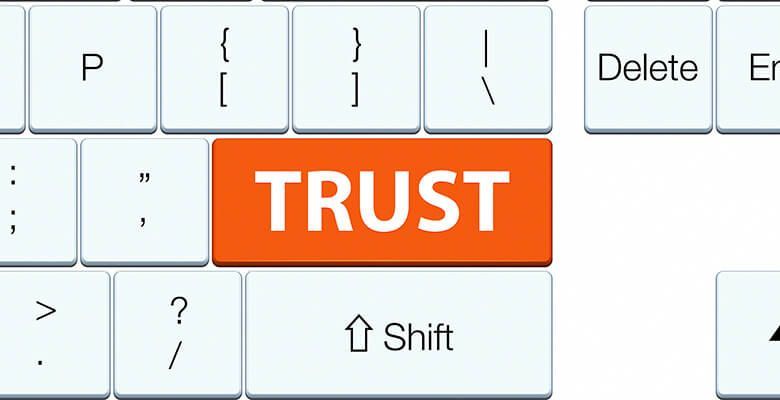Why is the topic of “trust” so important in e-commerce?
Competition in e-commerce is fierce. That's why, as an online shop operator, you have to win the trust of (potential) customers every day. Due to the old motto “The first impression counts”, it is important to give a convincing and trustworthy overall picture from the first second.
If you do not succeed in this, there is a risk that interested parties will leave your online shop within a very short time and buy from the competition. This means that all your (expensive) efforts will be wasted and you will not be successful.
How can you prevent this? Rely on trust elements! In other words, components that consciously and subconsciously show visitors: “You’ve come to the right place, you can trust this online shop. Stay here and shop with confidence!”
Which online shop components ensure trust?
Gaining people's trust is not that easy. If one or two things are wrong, potential customers will drop out. Accordingly, you have to play a range of measures. Here are a few tips:
Web design
The design of your online shop is like a business card: it must immediately convey to the visitor what awaits them here. A website that appears cheap or old-fashioned will immediately fail with most consumers.
Your online shop will appear contemporary and trustworthy if you rely on high-quality images or photos and offer videos or 360-degree views of products. A prominently placed search mask, a logically named menu and a friendly logo can also make the difference between a top or a flop.
Seal of approval
One of the most important trust elements of an online shop is quality seals. They make a significant contribution to building trust and have a positive influence on purchasing decisions - this is shown, for example, by the “Online Seal Monitor”.
The best-known seals of approval in the area of e-commerce are:
- Trusted Shops
- EHI
- Trust Pilot
- TÜV
Example: The visitBerlin.de online shop relies on Trusted Shops. If you click on the emblem, which is floating on the right-hand side, a popup opens with further information.
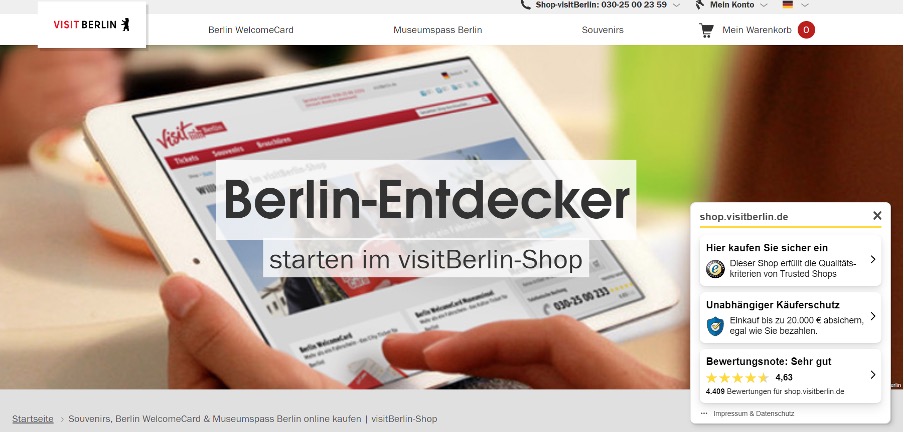

In addition to the seal providers named above, there are also Shopinformation, Shopvote, eKomi, OnTrustNet, ECommerce Europe Trustmark, Austrian E-Commerce Quality Mark and many others.
Many of the reputable online seals are expensive - but the price is worth it. Because as mentioned before, you create trust. However, if you use a cheap or unknown seal on your online shop, it can have exactly the opposite effect: visitors become suspicious.
Awards
Do you offer particularly popular or award-winning products? Or has your company won an award? Show it! Because as the saying goes: “Rattling is part of the craft”.
Bett1.de has almost perfected this. Every time you scroll down, at least one or two awards or seals will catch your eye.
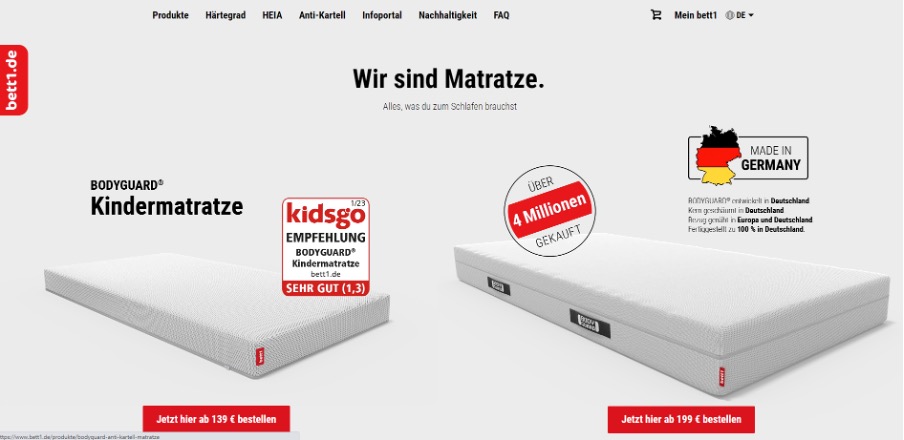

Payment methods
The trust-building measures also include the way your customers can pay for the products in your online shop. According to the EHI study “Online Payment 2022”, the following payment methods are important to German customers:
- Purchase on account
- PayPal
- Direct debit
- Credit card
Place icons with the payment methods on the homepage of your online shop. This shows you immediately how people can shop with you. This creates trust and at the same time reduces purchase cancellations.
Shipping service provider
Choosing the right shipping service provider can also determine the attractiveness of your online shop. Because modern customers expect their order to arrive safely and quickly.
Many online shop operators show the logos or icons of their shipping service providers and the payment methods in the same area of the online shop. At Kappa-Shop.de, for example, it looks like this:


Making contact
If a prospective customer has questions about your online shop or individual products, they want to get in touch with your team as quickly and easily as possible. If this is not possible, it will cost you trust - and possibly a customer.
The integration of contact options is a “must have” when designing the online shop. Include an item such as “Contact” or “Help” in your navigation or make your hotline number immediately visible. Or integrate a chat option.
Example: There is a chatbot integrated on the Libro.at website that helps you find the products you want.
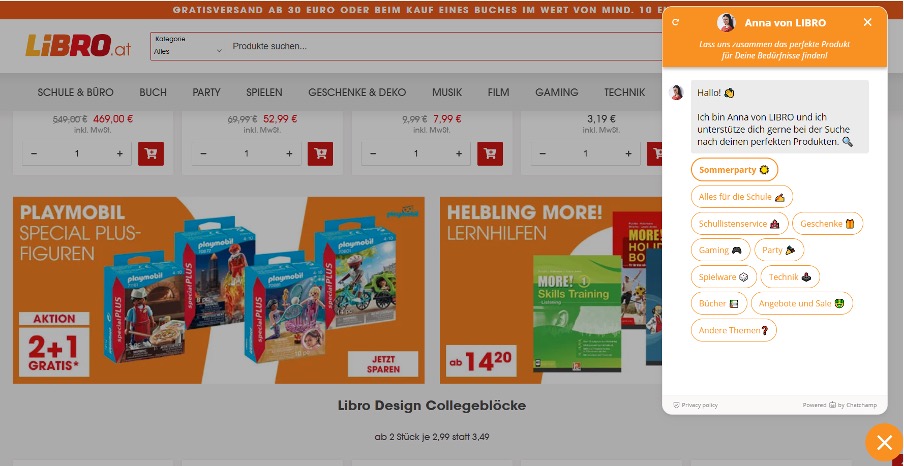

Security
Websites that are not encrypted with SSL are - rightly - considered a no-go! Savvy visitors can tell whether this is the case in your online shop by the small lock symbol in the address bar. But not everyone knows this. That's why it can't hurt to underline security with a logo.
For example, in addition to the trust elements mentioned, you can also display an SSL symbol or, as at UTB.de, the PCI-DSS seal.
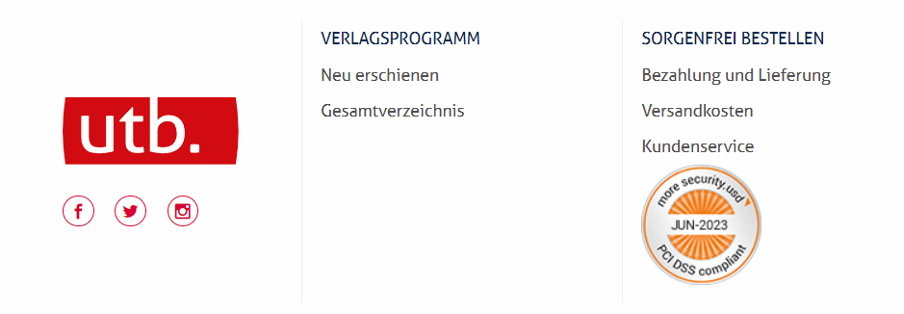

Where should the trust elements be placed?
There is no clear answer to this question. If you look at different online shops, you will see that trust elements such as quality seals and payment methods are used in different places.
Bausep GmbH has integrated the signets - as can be seen here - in the header area, but also in the footer.


You can find out where the best placement is through analysis. Use heatmap tools to do this. These record which areas of your online shop are clicked on particularly frequently or not at all by your users. And conduct audience testing and surveys.
Important: Think about responsive design when implementing it! This means your trust-building elements should be just as visible on a large PC monitor as they are on a small smartphone display.
Conclusion: Build trust
The trust elements mentioned may seem banal to you, but don't underestimate them! In the increasingly tough e-commerce business, small things can - apparently - make the difference between success and failure. It is therefore worth putting this topic on the agenda regularly.


